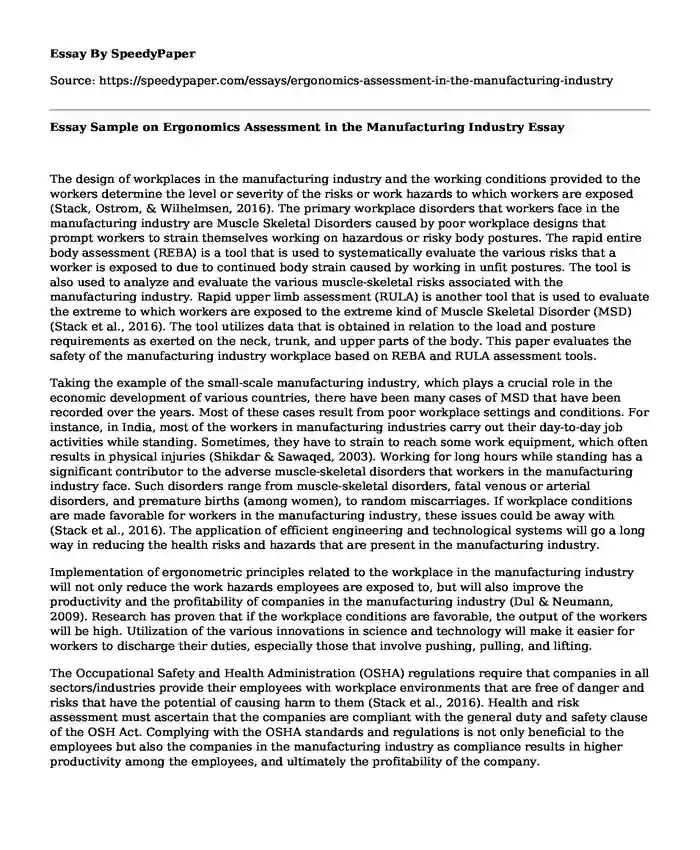
| Type of paper: | Essay |
| Categories: | Human resources Healthcare Disorder Employment law |
| Pages: | 3 |
| Wordcount: | 612 words |
The design of workplaces in the manufacturing industry and the working conditions provided to the workers determine the level or severity of the risks or work hazards to which workers are exposed (Stack, Ostrom, & Wilhelmsen, 2016). The primary workplace disorders that workers face in the manufacturing industry are Muscle Skeletal Disorders caused by poor workplace designs that prompt workers to strain themselves working on hazardous or risky body postures. The rapid entire body assessment (REBA) is a tool that is used to systematically evaluate the various risks that a worker is exposed to due to continued body strain caused by working in unfit postures. The tool is also used to analyze and evaluate the various muscle-skeletal risks associated with the manufacturing industry. Rapid upper limb assessment (RULA) is another tool that is used to evaluate the extreme to which workers are exposed to the extreme kind of Muscle Skeletal Disorder (MSD) (Stack et al., 2016). The tool utilizes data that is obtained in relation to the load and posture requirements as exerted on the neck, trunk, and upper parts of the body. This paper evaluates the safety of the manufacturing industry workplace based on REBA and RULA assessment tools.
Taking the example of the small-scale manufacturing industry, which plays a crucial role in the economic development of various countries, there have been many cases of MSD that have been recorded over the years. Most of these cases result from poor workplace settings and conditions. For instance, in India, most of the workers in manufacturing industries carry out their day-to-day job activities while standing. Sometimes, they have to strain to reach some work equipment, which often results in physical injuries (Shikdar & Sawaqed, 2003). Working for long hours while standing has a significant contributor to the adverse muscle-skeletal disorders that workers in the manufacturing industry face. Such disorders range from muscle-skeletal disorders, fatal venous or arterial disorders, and premature births (among women), to random miscarriages. If workplace conditions are made favorable for workers in the manufacturing industry, these issues could be away with (Stack et al., 2016). The application of efficient engineering and technological systems will go a long way in reducing the health risks and hazards that are present in the manufacturing industry.
Implementation of ergonometric principles related to the workplace in the manufacturing industry will not only reduce the work hazards employees are exposed to, but will also improve the productivity and the profitability of companies in the manufacturing industry (Dul & Neumann, 2009). Research has proven that if the workplace conditions are favorable, the output of the workers will be high. Utilization of the various innovations in science and technology will make it easier for workers to discharge their duties, especially those that involve pushing, pulling, and lifting.
The Occupational Safety and Health Administration (OSHA) regulations require that companies in all sectors/industries provide their employees with workplace environments that are free of danger and risks that have the potential of causing harm to them (Stack et al., 2016). Health and risk assessment must ascertain that the companies are compliant with the general duty and safety clause of the OSH Act. Complying with the OSHA standards and regulations is not only beneficial to the employees but also the companies in the manufacturing industry as compliance results in higher productivity among the employees, and ultimately the profitability of the company.
References
Dul, J., & Neumann, W. P. (2009). Ergonomics contributions to company strategies. Applied Ergonomics, 40(4), 745-752.
Shikdar, A. A., & Sawaqed, N. M. (2003). Worker productivity, and occupational health and safety issues in selected industries. Computers & industrial engineering, 45(4), 563-572.
Stack, T., Ostrom, L. T., & Wilhelmsen, C. A. (2016). Occupational ergonomics: a practical approach. John Wiley & Sons.
Cite this page
Essay Sample on Ergonomics Assessment in the Manufacturing Industry. (2023, Jan 22). Retrieved from https://speedypaper.net/essays/ergonomics-assessment-in-the-manufacturing-industry
Request Removal
If you are the original author of this essay and no longer wish to have it published on the SpeedyPaper website, please click below to request its removal:
- Immigration Research Paper Sample
- Comparison Essay Sample: Renting Vs Owning
- HR Essay Sample: Personnel Handling, Motivation and Communication Strategies
- Free Essay Example: Imperial Debris and Migration
- Free Essay about Controversies Regarding Morning After-pills for Underage Teens
- Digital Marketing Essay Example
- Essay Example on Audit Planning and Control of General Motors
Popular categories




